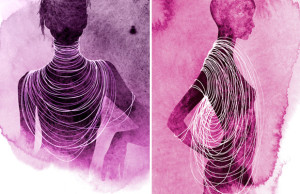Phallic and Phemale

Written by Sender Rozesz. Sender Rozesz is a practicing attorney with a background in Jewish pluralistic education for adults. Sender Rozesz is Jewrotica’s resident Double Mitzvah columnist. The views reflected in his writing represent his own personal views, and are not intended to reflect the views of any organizations, institutes or associations with whom he may be affiliated.

I have heard the lulav and etrog described before as blatantly phallic; a symbol of male preeminence and/or of pagan fertility rites within Jewish ritual. In fact, one contemporary commentator has suggested that “if there were two etrogs instead of one it would be clearer. But even with one, the idea seems pretty obvious.”
In fact, however, the lulav does indeed have a phallic character; but the etrog is entirely female. And, far from being pagan symbols, both the lulav and etrog represent the union of fairly lofty mystical concepts and divine energies.
But let’s back up.
Throughout the holiday of Sukkot, it is a mitzvah to take four different specific forms of vegetation — the Four Species — to bring them together, make a blessing and shake them. This commandment is derived from the Biblical verse: “And you shall take for yourselves on the first day, the fruit of the splendrous tree, date palm fronds, a branch of a braided tree, and willows of the brook, and you shall rejoice before the Lord your G-d for a seven day period.” [1]
Without getting into too much detail, the Talmud understood this verse as requiring three myrtle branches, two branches from a weeping willow, one palm frond, and one etrog.
Kabbalah teaches that, collectively, these four species represent the emotive characteristics of the Divine. The three sweet-smelling myrtle branches represent the three primary emotions and sefirot of Chesed, Gevurah and Tiferet: Kindness, Strength and Beauty. The two willow branches — which have no independent taste or smell qualities — are the two functional sefirot of Netzach and Hod: Victory and Splendor. The lulav — the palm frond — represents Yesod: Foundation. Finally, the etrog represents Malchut: Royalty.As we have discussed here on several prior occasions, the sefirah of Yesod, symbolized by the lulav, is representative of the penis. Conversely, Malchut, symbolized by the etrog, is famously female, often described as the Shekhina, or G-d’s Divine presence.
There are a few additional noteworthy features of the lulav/etrog pair:
- In addition to be symbolic of the sefirah of Malchut/Royalty, R’ Shimon Bar Yochai — the author of the Zohar — has said that the etrog represents the heart.
- The etrog is the first of the Four Species to be mentioned in the Torah, and is the only one described as the fruit of a “splendrous tree” (Eitz Hadar), and great pains are taken to buy etrogim specifically from Calabria, known for its particularly fertile and rich soil and beneficial climate for produce.
- When purchasing an etrog, many look for a slight horizontal indentation on the curvature of the etrog. This indentation — regarded as a desirable feature of an etrog — is known as “Eve’s Bite.” This is because according to some traditions, the fruit of which Eve fateful partook on that first day, and shared with her husband Adam, was actually the fruit of an etrog. Thus, the etrog is seen as associated with Eve, and as being corrective of the original sin.
- In terms of the etrog’s curves, another desirable feature of an etrog is known among Yiddish-speaking folk as a “gartel”: a waistband, or belt. Essentially and ideally, this would be a gentle horizontal indentation around the middle of the etrog, separating the etrog’s upper curves from its lower curves. Here is an example. Do you see it? This emphasis on the etrog’s curves simply add to its feminine character.
- The lulav itself is long and erect. However, Kabbalah points out that the penis, which is represented by the lulav, is the only limb of the body that actually changes its form, becoming functional (erect) only when sexually aroused and biologically prepared to fulfill is reproductive functions. The fact that the lulav represents the penis in its erect state is only because it is in the presence of the etrog, symbolizing its readiness to consummate the mystical couplings of Sukkot.
Thus, far from being a meaningless ritual, a mere remnant of a pagan past; or a statement of phallic supremacy, when we bring the lulav, etrog, myrtle and willow branches together, we are causing cosmic spiritual unions, uniting the potent male and female energies of the Divine.
So, if you don’t have your own set of the Four Species, find someone who does, take them into your hands, make the blessing, bring them together, and think of their significance as you join in the metaphysical sexuality of the lulav and etrog.
Chag Same’ach and Shabbat Shalom![1] Leviticus, 23:40.













0 comments